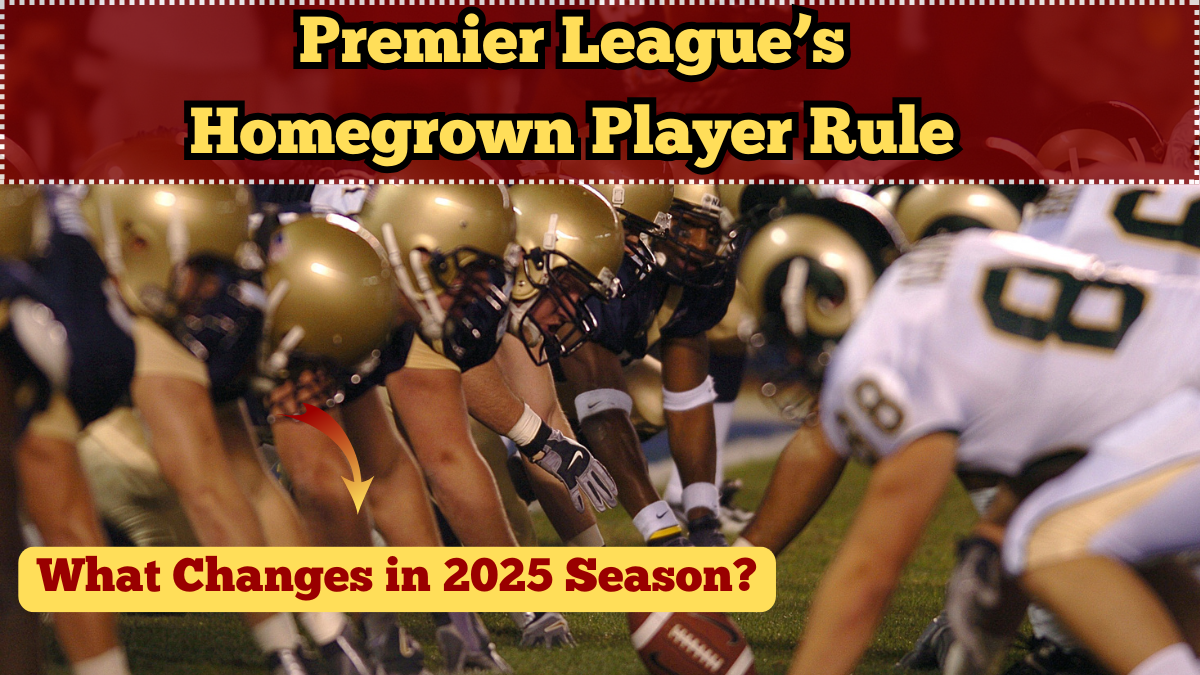The Premier League 2025 season is not just shaping up to be thrilling on the pitch—it also brings key regulatory changes behind the scenes. One of the most discussed updates is the redefinition and stricter enforcement of the homegrown player rule, which directly affects club squad selection, youth development strategies, and the broader transfer market.
The homegrown rule has existed in the EPL transfer rules for over a decade, but in 2025, new criteria and penalties are being introduced to encourage deeper investment in domestic talent. As global football becomes more competitive and post-Brexit restrictions limit access to EU talent, the Football Association (FA) is pushing clubs to cultivate more homegrown stars. This article will break down what the rule entails, how it has changed, and how clubs must respond during the 2025 season.

What Is the Homegrown Player Rule?
Under the original homegrown player rule, Premier League clubs were required to register no more than 25 players over the age of 21 in their squad, of which at least 8 must be homegrown. A homegrown player is defined as one who, irrespective of nationality or age, has been registered with an FA-affiliated club for at least three seasons before the age of 21.
As of 2025, the rule has been tightened to include:
-
12 homegrown players required in a 25-man squad (up from 8)
-
Minimum 3 players developed at the club itself—not just at other English academies
-
Increased emphasis on playing minutes for homegrown players across the season
These revisions reflect a growing concern that top clubs were merely meeting the quota through fringe players without genuinely integrating domestic talent into first teams.
Why the Rule Is Changing in 2025
Several factors influenced the FA’s decision to amend the EPL transfer rules in 2025:
-
Brexit regulations restrict clubs from signing foreign players under 18, narrowing the youth talent pool from abroad.
-
The Premier League wants to enhance the competitiveness of the England national team, and increasing the playing time of domestic players is seen as essential.
-
Rising transfer fees for foreign stars have made clubs reconsider the financial viability of ignoring academy development.
-
There is growing pressure from fans and pundits for clubs to “grow their own” rather than rely on expensive imports.
The Premier League 2025 season marks the first time these new quotas are being actively enforced with squad restrictions and financial penalties for non-compliance.
How Clubs Are Adapting to the New Rule
Premier League clubs have responded to the updated homegrown player rule in several strategic ways:
-
Expanding youth academies: Clubs like Chelsea, Manchester City, and Aston Villa have invested heavily in infrastructure and coaching to retain more academy players.
-
Fast-tracking U21 players: Promising young talents are being introduced earlier into senior teams to meet the “developed at club” clause.
-
Loan recall strategies: Several clubs are recalling previously loaned-out youth players to build their homegrown numbers and comply with the rules.
Here’s how the updated squad composition looks for a standard 25-man list in Premier League 2025:
| Squad Category | Requirement | Notes |
|---|---|---|
| Total registered players | Max 25 players | Over the age of 21 |
| Homegrown players (any club) | At least 12 | Must have trained in England for 3+ years |
| Homegrown from own academy | Minimum 3 | Developed at the registering club |
| Foreign players | Max 13 | No changes to foreign player definition |
These changes force clubs to not only register domestic players but also genuinely develop and trust them on the field.
Impact on Transfers and Team Dynamics
The revised EPL transfer rules are already having a ripple effect on how clubs operate in the 2025 market:
-
Inflated transfer fees for English players: Homegrown stars like Declan Rice, Jude Bellingham, and Cole Palmer command even higher valuations due to their rule compliance value.
-
Increased competition for English youth: Lower-table clubs and Championship teams now face fierce competition for emerging English talents.
-
Reduced squad depth for teams that failed to plan ahead—some top clubs have started the season short-handed due to non-compliance.
Additionally, clubs that exceed the foreign player limit or fail to meet homegrown criteria can face:
-
Fines up to £1 million
-
Point deductions for repeat violations
-
Transfer bans during the winter window
These are part of a broader push to create more equitable and development-focused policies in the Premier League 2025 season.
FAQs
What is the homegrown player rule in the Premier League 2025?
Clubs must register at least 12 homegrown players in their 25-man squad, including 3 developed at their own club.
Who qualifies as a homegrown player?
Any player, regardless of nationality, who has been registered with an English or Welsh club for 3 years before turning 21.
What happens if a club doesn’t meet the homegrown quota?
They will have to leave unfilled slots in their squad, face financial penalties, and potentially suffer competitive sanctions.
How are clubs identifying homegrown talent now?
Most clubs are investing more in their youth academies and scouting within England to meet the homegrown criteria.
Does the rule apply to under-21 players?
No. U21 players can be used freely and do not count against the 25-man squad limit or homegrown quota.
Click here to know more.
Aanchal is a passionate writer with a keen interest in storytelling, content creation, and creative expression. She enjoys exploring diverse topics and crafting engaging narratives that captivate readers.




